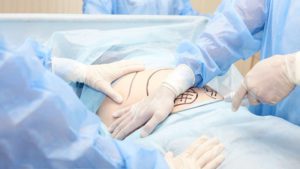Dr Barretts Tips for The Ultimate Brazilian Butt Lift Recovery
Congratulations! We’re sure you’re feeling pretty uncomfortable right now, but rest assured: you’re on your way to your new self! But first. you’re going to
Receive FREE UPS® Ground delivery for domestic orders over $200!

Thorough, intentional post-operative care is essential for reducing complications while the body is healing from surgery. The recovery period after any surgery is a delicate and vulnerable time, but with the proper pre-op preparation, patients can spend more time focusing on rest and wellness. The first step in preparation is to ensure a safe, supportive environment for recovery. This means making childcare or pet care arrangements, taking time off from work or other duties, and organizing travel accommodations to and from the hospital.
On average, it takes around two weeks of recovery before gradually returning to normal activities. Those who exercise frequently must slowly reincorporate vigorous activity, starting small before working back up to their regular routine. The exact duration of necessary downtime is dependent on the intensity of the procedure, varying from a few days to a few weeks, but for any surgery, the first 48 hours are crucial. During this time, patients should avoid all strenuous activities while paying close attention to pain management and caring for the wounded areas. Each patient will be given specific post-op instructions detailing how long they are expected to refrain from work and exercise.
In the days directly following surgery, for more invasive surgeries, it may be necessary to enlist the help of a loved one or nurse to help move around, attend to incisions and drains, or prepare meals. Post-op instructions will include step-by-step directions on how to keep wounds clean and what to look for regarding possible infection or complication. Wounds and bandages should remain dry and clean to prevent bacteria. Issues such as discoloration of the skin, excessively high levels of pain, intense swelling, or disfigurement should be immediately reported to the doctor. Other indications of infection include fever, chills, nausea, and discharge from the surgical site.
Patients can expect to feel low to mild pain, discomfort, and swelling that will continuously decrease as the healing process continues. Pain management medication is prescribed based on the individual procedure, but successful patients utilize alternative pain management methods like cold compresses, elevation, and relaxation techniques. Some minor, low-impact exercises, massages, and stretches may be recommended based on the procedure, as a balance of movement and rest is key to recovery. Proper nutrition, hydration, and hygiene also influence the intensity and duration of the body’s healing process. Though ordering out and throwing healthy eating habits out the window while spending days in bed is an attractive thought, it’s best to supply the body with nutrients and as much water as possible to reduce complications. Snacking on fruits with high water levels can help curb cravings while still ingesting nutrients and staying hydrated.
Many patients create a post-plastic surgery kit before their procedure to help navigate their road to recovery. These kits usually contain the proper clothing, compression garments, bandages, scar tape, supplements, and any other necessary medications. At Barrett Beverly Hills, holistic care extends past the surgical room — in addition to any prescribed medications, Dr. Barrett offers natural and safe products beneficial to the healing process that wonderfully complement anyone’s recovery kit. Natural ingredients like magnesium, arnica, and even CBD, aid in supporting comfort and immune function without adding more prescriptions.
One aspect of recovery some people forget to mention is the psychological impact of surgery; it’s normal to feel stressed or anxious before, during, and after a procedure. Discussing these emotions with your doctor or mental health professional can help manage any ruminating thoughts or stress. For those losing sleep due to an anxious mind, supplements like CALMg daily magnesium help regulate emotions and promote relaxed sleep, assisting patients to fall asleep faster and longer.
Follow-up appointments will be scheduled in advance so the doctor can monitor healing, check for signs of complications, and answer any lingering questions, no matter how small. These are opportunities to speak with the surgeon about any necessary revisions or just general inquiries about the process. Each follow-up appointment should be attended for safety purposes, as this is the best way to prevent complications or correct them before they become dangerous.
Post-surgery recovery can feel daunting, so preparing in advance is the best way to avoid feeling overwhelmed. In addition to following instructions and creating a recovery kit, patience and realistic expectations help create a positive mindset around healing. Remembering that the body’s ability to heal itself cannot be done overnight is important. Celebrating recovery milestones, like removing stitches or ceasing to wear compression garments, helps us remind ourselves that healing is a journey.
Congratulations! We’re sure you’re feeling pretty uncomfortable right now, but rest assured: you’re on your way to your new self! But first. you’re going to
Whether it’s elective or not, inflammation or swelling after surgery is a reality anytime you go under the knife. Inflammation, which is actually an inflammatory

When it comes to any surgery, planning for after the procedure is the answer to a speedy and comfortable recovery. Preparing ahead helps to reduce stress. Taking


Congratulations! You’ve just made a life-changing decision to look and feel your best, and you’re on your way to your new self! But you’re going


Congratulations! We’re sure you’re feeling pretty uncomfortable right now, but rest assured: you’re on your way to your new self! But you’re going to go


For some, making the decision to change their body through breast reduction surgery is an easy one; for others, there can be months or even years of
Always consult with your physician before using
any of the products and materials available for purchase on our website.
Always consult with your physician before using
any of the products and materials available for purchase on our website.
A Dr. Daniel Barrett company
Visit:
www.drdanielbarrett.com

